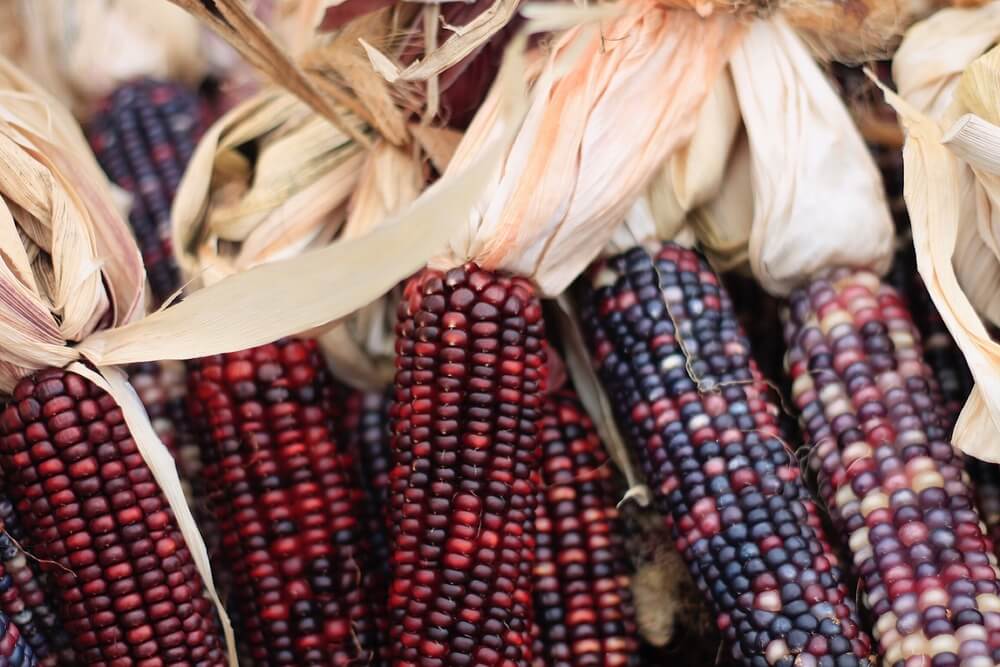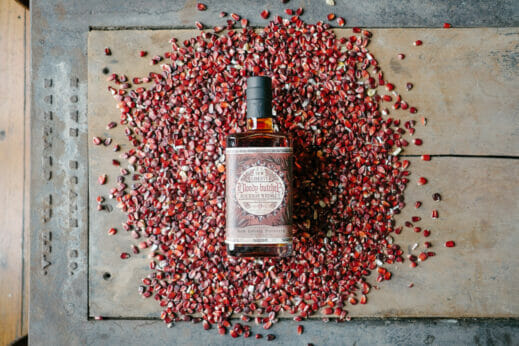How Distilling Almost Killed—Then Revived—One Of America’s Heritage Crops
Bloody Butcher Corn, once grown widely for use in moonshine, was on the brink of extinction until modern distillers brought it back from the dead.
How Distilling Almost Killed—Then Revived—One Of America’s Heritage Crops
Bloody Butcher Corn, once grown widely for use in moonshine, was on the brink of extinction until modern distillers brought it back from the dead.

by Shutterstock
Along the eastern seaboard, there’s a growing network of folks interested in reanimating the dead—or, at least, the nearly dead. “There’s definitely a robust network on the eastern seaboard of people in brewing, distilling, academics and malting that are building on a lot of these storylines and getting some of these varieties back into the public’s hands,” says Brent Manning, certified cicerone (like a historian for beer and spirits) and co-founder of Asheville, NC-based Riverbend Malt House.
He’s talking specifically about Bloody Butcher Corn—a hybrid of Hackberry Dent and Red Corn, with deep maroon kernels and a complex taste. It was named for the way it resembled a bloody butcher’s apron when milled. Prominent in the late 1800s in the United States, especially the Virginia area, it was used for corn meal, animal feed and even whiskey, seemingly securing its place in American farming heritage.
But at the height of the Industrial Revolution, that all changed. Corn became increasingly commercially grown and farmed, and many heirloom varieties of the crop decreased or even disappeared. American farmers mainly turned away from planting these legacy seeds as other varieties grew in prominence.
“It’s a really interesting arc from the early days of colonizing America, which was growing whatever we could get. Then when we got into the industrial age, it was a very quick flip to just wanting something that we could make easily,” says Manning.
It turns out that, by 1890, according to a research paper by David Shields, an English professor and heirloom foodways expert at the University of South Carolina, that “consistency achieved despite differences in weather, terroir, grain variety, and formulation” was the top priority for farmers. Add to that the addition of distillers looking to mute the flavor of the corn by adding other types of wheat and Shields says that, from then on, there was “large-scale adoption of Reid’s Yellow Dent and its descendants such as No. 2 Yellow Dent.”
Bloody Butcher tends to grow a lower yield than other types of corn, especially the yellow corn varieties. The increased demand for corn in larger quantities, namely in the distilling industry, ended up swaying farmers to plant corn for which they would get paid the most, says Manning. It is also a variety that, to this day, remains free pollinated. “Still today, if they plant [Bloody Butcher] too close to other varieties, they can still have a situation where it is not 100% red kernels that come out of the cob,” Manning explains.

Seeding and planting Bloody Butcher means crews need to stay vigilant, even in modern times. Distiller Joyce Nethery emphasizes that, since Bloody Butcher is open pollinated, the team at Jeptha Creed needs to be diligent about saving the seeds and monitoring the fields. And that’s not all. “Bloody Butcher, when you look at the field, its ears are everywhere,” she says. “In fact, sometimes, you need to use a stepladder to be able to pull it off the stalk. That also makes it top heavy, so in August thunderstorms, it falls over and lodges real easily, which has made it a challenge,” adds Nethery.
Add to that the lower yield per acre and the round of handpicking that must be done, as the commercial machines aren’t as honed in to harvesting Bloody Butcher and other heirloom crops, and it may seem that the effort may not be worth the prize.
While, historically, distillers thought that yellow corn was a richer product, according to Shields, it turns out that craft distillers today are seemingly returning to the heirloom roots. However, some distillers are proving that untrue. The flavors and nuances it is bringing back to the bourbon industry has had craft bourbon and rye professionals taking another look at this almost-lost corn.
“We thought, ‘should we use the corn that everybody else has or do we want to try something new’’,” says Autumn Nethery, co-owner and marketing manager for Jeptha Creed (her mother, Joyce, is the master distiller and the distillery itself was a dream of her father, Bruce). “We have a home farm and we wanted this to be a farm-distillery. So, we grew the corn ourselves.”
Rob Cassell, founder, owner and master distiller of Philadelphia, PA-based New Liberty Distillery, also started growing his own corn—on just a single acre of land—to make classic corn moonshine. Cassell harvested and processed the corn himself, too.
“What most folks love about this is how far off the beaten track it is from the typical notes of brown sugar and vanilla,” he says in an email, explaining that the corn pushes the liquid into savory and full-bodied notes of leather and stone fruit, without a cloying taste.
“One of the things that you really get with Bloody Butcher is this nutty, sweet earthiness that you don’t get from yellow corn,” says Joyce Nethery, who uses the variety in all of its spirits. She also says there is a banana component to bourbon made with Bloody Butcher, and the sipper ends up being a lot more fruit forward than others.
While the Nethery family still grows its own Bloody Butcher onsite, Cassell now prefers to locally source his corn instead of attempting to grow it on his own.“Sourcing grain is always the main challenge in that you need to ensure you can get it in bulk and that the farmer can grow with the product’s demand. Currently, though, we get the grain from Dancing Star Farms in Imler, PA,” he says.
And, says Cassell, new bourbons using experimental corn varieties are poised for growth, especially in the craft distilling world, as consumers clamor for booze that has a story to tell.
“A limitation of larger distilleries is the issue of supply and demand. Working in true small batches allows the craft community to look to their local agricultural neighbors for the obscure and forgotten grains. It’s very cool to see fellow distillers reaching for the Bloody Butcher, Wapsie Valley, Blue Corn or any other heirloom variety as it further expands what whiskey can offer,” says Cassell.
Bloody Butcher went from one of the most well-known corn varieties in the 1840s to virtually non-existence in the 20th century. While the slow food and farm-to-table movements were critical to reviving it, even in small numbers, there are plenty of brewers and distillers out there that are looking to give this crop a wonderful comeback story.
Follow us
This work is licensed under a Creative Commons Attribution-NoDerivatives 4.0 International License.
Want to republish a Modern Farmer story?
We are happy for Modern Farmer stories to be shared, and encourage you to republish our articles for your audience. When doing so, we ask that you follow these guidelines:
Please credit us and our writers
For the author byline, please use “Author Name, Modern Farmer.” At the top of our stories, if on the web, please include this text and link: “This story was originally published by Modern Farmer.”
Please make sure to include a link back to either our home page or the article URL.
At the bottom of the story, please include the following text:
“Modern Farmer is a nonprofit initiative dedicated to raising awareness and catalyzing action at the intersection of food, agriculture, and society. Read more at <link>Modern Farmer</link>.”
Use our widget
We’d like to be able to track our stories, so we ask that if you republish our content, you do so using our widget (located on the left hand side of the article). The HTML code has a built-in tracker that tells us the data and domain where the story was published, as well as view counts.
Check the image requirements
It’s your responsibility to confirm you're licensed to republish images in our articles. Some images, such as those from commercial providers, don't allow their images to be republished without permission or payment. Copyright terms are generally listed in the image caption and attribution. You are welcome to omit our images or substitute with your own. Charts and interactive graphics follow the same rules.
Don’t change too much. Or, ask us first.
Articles must be republished in their entirety. It’s okay to change references to time (“today” to “yesterday”) or location (“Iowa City, IA” to “here”). But please keep everything else the same.
If you feel strongly that a more material edit needs to be made, get in touch with us at [email protected]. We’re happy to discuss it with the original author, but we must have prior approval for changes before publication.
Special cases
Extracts. You may run the first few lines or paragraphs of the article and then say: “Read the full article at Modern Farmer” with a link back to the original article.
Quotes. You may quote authors provided you include a link back to the article URL.
Translations. These require writer approval. To inquire about translation of a Modern Farmer article, contact us at [email protected]
Signed consent / copyright release forms. These are not required, provided you are following these guidelines.
Print. Articles can be republished in print under these same rules, with the exception that you do not need to include the links.
Tag us
When sharing the story on social media, please tag us using the following: - Twitter (@ModFarm) - Facebook (@ModernFarmerMedia) - Instagram (@modfarm)
Use our content respectfully
Modern Farmer is a nonprofit and as such we share our content for free and in good faith in order to reach new audiences. Respectfully,
No selling ads against our stories. It’s okay to put our stories on pages with ads.
Don’t republish our material wholesale, or automatically; you need to select stories to be republished individually.
You have no rights to sell, license, syndicate, or otherwise represent yourself as the authorized owner of our material to any third parties. This means that you cannot actively publish or submit our work for syndication to third party platforms or apps like Apple News or Google News. We understand that publishers cannot fully control when certain third parties automatically summarize or crawl content from publishers’ own sites.
Keep in touch
We want to hear from you if you love Modern Farmer content, have a collaboration idea, or anything else to share. As a nonprofit outlet, we work in service of our community and are always open to comments, feedback, and ideas. Contact us at [email protected].by Emily Cappiello, Modern Farmer
March 29, 2023
Modern Farmer Weekly
Solutions Hub
Innovations, ideas and inspiration. Actionable solutions for a resilient food system.
ExploreShare With Us
We want to hear from Modern Farmer readers who have thoughtful commentary, actionable solutions, or helpful ideas to share.
SubmitNecessary cookies are absolutely essential for the website to function properly. This category only includes cookies that ensures basic functionalities and security features of the website. These cookies do not store any personal information.
Any cookies that may not be particularly necessary for the website to function and are used specifically to collect user personal data via analytics, ads, other embedded contents are termed as non-necessary cookies.
Can you eat it, fresh or dried? Pop it?
You can’t really have a discussion about heritage corns, especially Bloody Butcher, without including Gary Hinegardner at Woodhat Distillery. He is the Godfather of heritage corns- knows more than anyone.
Liberty Pole Spirits in Washington , PA uses it. They are at the home of the Whiskey Rebellion and use bloody butcher corn and recipes from 1791, when the rebellion occurred.